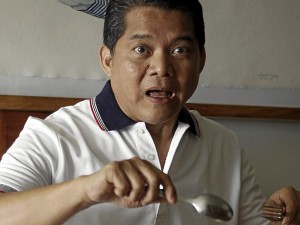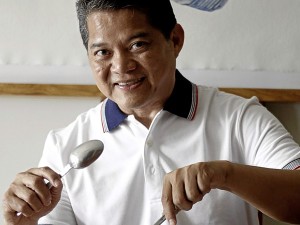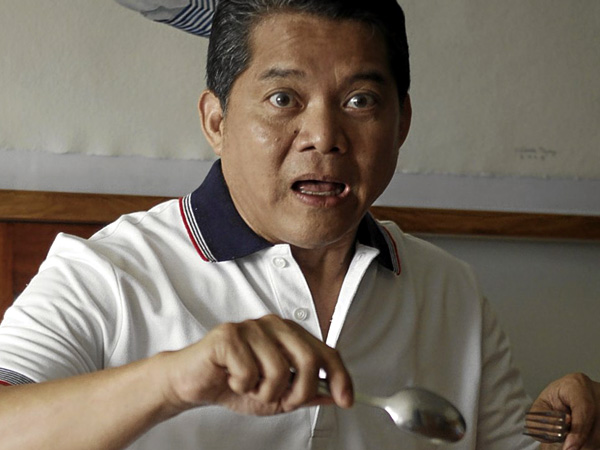
Like a hero in a science fiction story, Claude Tayag seems to live in three different worlds all at once. But if you ask him, it’s the same world with different aspects to it. Widely known for being a visual artist and an accomplished chef with a devotion to Kapampangan cuisine, Claude has also emerged as an engaging food writer and author.
“There’s an expression, ’jack of all trades, master of none.’ I would like to call it a master of all,” declares Claude (pronounced “clawd”), a man who resides in different stories that all begin in the kitchen.
Claudio Suarez Tayag was born in Angeles City in 1956, the ninth of 12 children to developer and writer Renato Tayag, part of the well-known Tayag clan from Pampanga. His mother, Adoracion, had to raise 12 kids, so the woman has the equivalent of “a doctorate degree in homemaking,” says this son.
In his teens, Claude observed how everyone had to follow an eating schedule, and since he didn’t like eating leftovers, he learned to improvise in the kitchen. “If you want something, you go get it or make it yourself.”
So started Claude’s journey of self-evolution; he would be self-taught in food as in other exploits and would learn whatever it was he needed to do.
He started by discovering his affinity for the visual arts. As a child in school, he enjoyed drawing as most kids do, and recalls how his father would invite artists like Vicente Manansala and Malang Santos to paint in the outdoors of the subdivisions he was developing. He remembers one such photograph where he, a boy of 9, would be standing in front of a group of artists. “This is what I want to be when I grow up,” he remembers telling himself. “Here are grownup people doing child’s play. I didn’t know there was a profession like that.”
Naturally, Claude wanted to take Fine Arts at the University of the Philippines in Diliman (UP is a family tradition, he says), but his father objected, saying that his son needed to learn a trade. So Claude ended up taking architecture.
But though he excelled in arts-related and math-related subjects, Claude started losing interest when engineering subjects came up in his third year. So he’d wander off to the College of Fine Arts where he would sit in in the class of Dean Jose Joya, a friend of his older sister. He would also spend weekends with his father’s friend, the writer and artist Emilio Aguilar “Abe” Cruz.

Exposed to the arts, he wanted to drop out of architecture in his fourth year but his father made him a deal: Just finish a college course and then he can paint as much as he wanted to. In the end, Claude wound up with a degree in economics from UP Clark in 1978. Then he was free.
Like a prisoner who managed to escape jail, Claude made the most of his newfound freedom and mounted his first art exhibit in 1978 when he was 22. He went on to a flourishing career as a professional artist, staging his own one-man show in wood in 1990. He continues to paint and design when he can. “I find time for it when I have to,” he says with a laugh.
Since Claude’s college friends knew he was from Pampanga, they would call up on the weekends on their way to Baguio to ask him to cook for them. In every outing, he would be assigned to take care of the food, an experience he shared with his siblings.
Even when he was already a professional artist in Manila, he liked hanging out with foodies and restaurateurs. Having grown up around Abe Cruz, he always knew Cruz’s son Larry, who owned the LJC group of restaurants. “He was like my older brother and he knew that I cooked,” Claude recalls. The first time he cooked professionally was when Cruz invited him to be the guest chef for two years at AngHang in Sunvar Plaza starting 1988.
That started Claude on a course that would take him to five-star hotels where he became an accomplished, self-taught chef, learning from the best by starting at the very top during his on-the-job training.
Whenever he would travel as an artist, Claude would bring home new ingredients and then experiment. For 11 months, he backpacked through Europe, learning how to cook paella in Spain.
He had one particular moment of lucidity when he attended a lunch for the Saturday Group of artists at Via Mare in Greenbelt. While the others passionately discussed technique and style, he found himself thinking about the food instead, how to cook certain dishes and how to plate them. “Cooking is like a performance art because you involve the viewer by engaging all his senses,” he says. “That’s when I realized food was a pursuit worth following. This is another avenue for me to express my artistry. Cooking is an art form. That’s why we call it culinary arts.”
He also began selling a line of sauces, now called Claude’9, that include his famous taba ng talangka (crab roe). After Claude married long-time friend Mary Ann Quioc in 1998, the couple turned the pursuit into a business. Today, they produce 200 bottles of sauces a day, along with frozen, ready-to-eat meals.
As a family man, Claude started building his own house whom he called Bale Dutung, Kapampangan for “house of wood.” When his house was finished, he invited Ada Mabilangan, food critic Doreen Fernandez and publisher Karina Bolasco, among others, to come over for lunch. His guests suggested that he open the house to “people you know or people you like, kindred spirits,” Claude quotes Fernandez as saying. She also wrote about that lunch and the phone had not stopped ringing since.
Bale Dutung has since become a culinary destination, with Claude now rolling out three menus several times a month (Check it out on Baledutung.com).
Because of her training as chief purser for Cathay Pacific, Mary Ann is like a savant for meticulous details, Claude says, making them an unbeatable foodie team. “It’s a perfect partnership, I take care of the kitchen at the back of the house and Mary Ann takes care of the front of the house,” says Claude. He still cooks for himself on a daily basis. One dish he would never tire of is his nilagang manok at baboy. He loves the flavor from the skin and the bones.
From food came his next evolution: Claude Tayag as writer. He describes himself as a voracious reader in college, especially of best-selling novels by the likes of Robert Ludlum, for example. “It was like watching several different movies,” he recalls.Out of the blue, he was asked to write for a daily newspaper in 2000, in a “no pressure, just submit anytime” arrangement.” His first article was about his and Mary Ann’s trip to Bangkok, with him producing a chronicle of what they did.
The editor liked it, and Claude gained enough confidence to send long letters home to his family and friends along with hand-painted watercolor postcards while he was traveling in Europe. At the end of his 11-month backpacking sojourn in Europe, they gave him back the postcards he sent. “It was like a record of my travels. One day I would like to turn it into a book,” he remembers thinking.
Thus was born “Food Tour: A Culinary Journal,” which was published by Anvil in 2006. The book gathered his newspaper columns and featured his recipes and black-and-white illustrations. “It’s a three-in-one thing that reflects me as a writer, a chef and artist,” he says. The book would go on to win the Best Culinary Travel Guide in the international Gourmand World Cookbook Awards in 2007.
Claude’s next project would be an ambitious one. In 2008, he was one of six authors and cooks who crafted “Kulinarya: A Guidebook to Philippine Cuisine.” The book, he says, was not supposed to standardize Filipino cuisine—which after all is known partly for its improvisation—but to present a range of the “best practices.” It offers up a spectrum of options instead of limitations. “Adobo is treated as a technique, not a dish-there are five recipes of adobo in it.”
His third book was a collaboration with Mary Ann. “Linamnam: Eating One’s Way Around the Philippines” took three years of traveling around the country and taking serious notes. “Linamnam” is a collection of the couple’s recommendations of what to eat where, from Amianan to Mindanao. “It’s a culinary mapping,” he explains.
But while his books follow in the tradition of Philippine food writing exemplified by the late Doreen Fernandez, they also differ in that they not only tell a story but also feature recipes. “The recipes are harder (to do) because you have to kitchen-test them many, many times especially nowadays because people will get back to you if it doesn’t work.”
He can also tell engaging stories about the food and dishes he features in his books. He tells of how an 1732 Spanish friar had published a Spanish-Kapampangan dictionary that already had the word “sisig” in it, how the famous Aling Lucing reinvented the dish in the 1970s and how in 1980, his brothers brought the recipe to Metro Manila by establishing Trellis in Quezon City, which incidentally gave birth to the so-called grill resturants. “Sisig should be the national dish,” he quotes TV host, chef, writer and critic Anthony Bourdain as saying.
Just like his cooking, Claude learned to write because he had to. “I write when I am inspired or excited to tell a story.” He’s now working on a new commissioned cookbook, but he does have one thing he dreams of doing: “A food movie.” It is his “ultimate dream,” he says.
He would shape the movie in the tradition of the Spanish film “Como Agua Para Chocolate (Like Water for Chocolate),” but with Filipino food and a Kapampangan setting. He has spoken to director Elwood Perez and screenwriter Raquel Villavicencio about it, and about featuring an all-Kapampangan creative cast.
Since “Like Water for Chocolate” started as a novel by Laura Esquivel with actual recipes in it, Claude would actually be one of the few people qualified to pull off a movie with a similar theme.
These days, Claude continues to run the woodworking business that is his bread-and-butter. It is what enables him and Mary Ann to travel as much as they do.
Already an acknowledged food authority, Claude walked bad boy chef Anthony Bourdain through Pampanga cuisine when he made an episode on the Philippines for his TV show, “No Reservations.” He says of the infamous author of “Kitchen Confidential,” the book that exposed the seamy side of the food business in the US: “He was very nice, nothing of that abrasive and cussing guy you see on TV.”
Claude has a lot on this plate this year. In May, he travels to Memphis, Tennessee to take part in the Memphis in May Festival. Every year, Memphis hosts a guest country and this year, it’s the Philippines’ turn with Claude invited to prepare a menu that properly represents Filipino food. He will also be holding an exhibit in Memphis. That double duty will also be done in Rome, Italy as the Philippine ambassador to Rome, Virgilio A. Reyes, has invited Claude to offer up a menu for the June 12 festivities—and do a one-man show while he’s there as well. Aside from a plan to bring distinctive Philippine fruits like macopa and atis to Rome, Claude is pondering whether to showcase his existing work or to come up with something new for the events.
It’s all about celebrating our food, he says. “It’s a celebration of the Filipino, showing its diversity,” Claude declares.
It might as well be a celebration of the unique convergence of talent that is this artist, writer and chef, and of the one ingredient he uses in his multiple pursuits: “Never limit yourself. Become what you can be.”









































